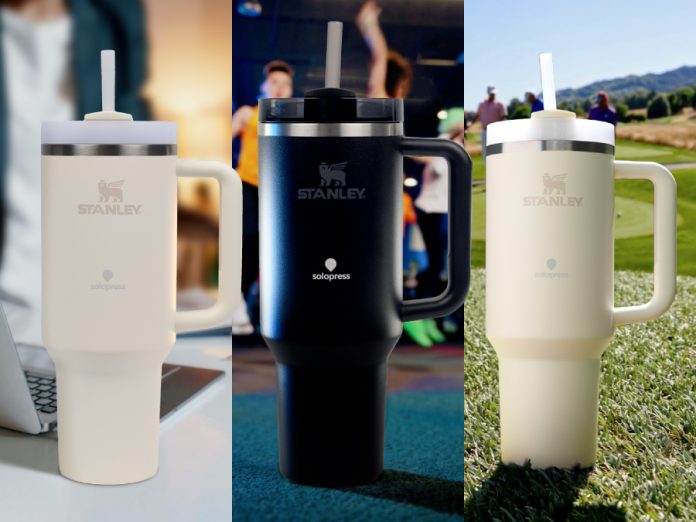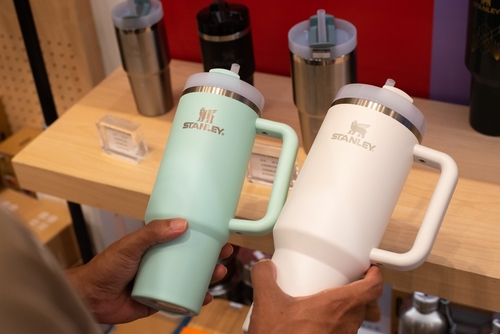Stanley cups have become a social media sensation—but many are surprised to learn they’re not made by the same Stanley behind the iconic utility knife. The drinkware brand is an entirely separate company, founded in the United States in 1913, and best known for its durable, vacuum-insulated bottles. Originally popular among workers and outdoor enthusiasts, Stanley’s practical stainless-steel flasks quietly endured for decades. But more than 100 years on, the brand has found unexpected fame—propelled into the spotlight by a viral TikTok trend.
TikTok and beyond
Starting in 2020, Stanley cups began to appear in the hands of social media stars, kickstarting the trend. In 2023 we saw an explosion in the market for Stanley cups as Water-Tok became a viral trend on TikTok. Water-Tok is a divisive phenomenon where primarily American influencers post videos of themselves preparing their daily water. The controversy arose thanks to the outrageous amounts of sugar that some influencers would add. As with many aspects of the internet, enragement sparks engagement, and the trend quickly took root in mainstream culture. All of this, however, led to a lot of screen time for the Stanley cups that TikTokers would use to keep their water cool throughout the day.
This high-level of exposure allowed Stanley cups to break out beyond TikTok and become an overwhelming trend. From this point we began to see more and more famous influencers and icons in meaningful relationships with their Stanley cups. Celebs such as, Trixie Mattel, Adele and Trisha Paytas have all been seen sipping away from their Quenchers, amplifying the buzz around this sought-after product.
How do Stanley cups work?
The principle is vacuum insulation. Each cup features a double-walled stainless steel body with a vacuum between the layers. Because there’s no air in the vacuum layer, heat transfer through conduction and convection is significantly reduced, helping drinks stay hot or cold for longer.. While the principle is the same whether the contents are hot or cold, different Stanley products are tailored to different types of drink. The AeroLight™ Transit Mug with its 0.47l capacity and drink-through lid, is ideal for hot beverages.. On the other hand, the Quencher H2.0 FlowState™ Tumbler, with its greater capacity and FlowState or Flip Straw options, is ideally suited for refreshing cold drinks. No surprise, then, that this was the model adopted by influencers leading the hydration trend.
What makes a Stanley Cup so desirable?
One of the most remarkable aspects of the Stanley cup is its durability. There are numerous online testimonies of cups surviving drops, dents and even fires—some users claim their cup kept water cold even after being recovered unscathed from a burnt-out car! This ruggedness gives the product a practical value beyond the trend.
The Stanley Quencher H2.0 FlowState™ Tumbler comes in a variety of sizes including 1.2L, 0.8L and 0.6L, allowing customers to pick the best fit for their daily routine and hydration goals. The larger designs reduce the need for frequent refills, while keeping drinks ice cold for up to 11 hours. All sizes come with a reusable straw and a three-position FlowState lid that can be rotated to suit different drinking preferences: straw access, open sip, or full cover.
What is the most popular Stanley Cup?
The Quencher is the current star of the Stanley range, with the 1.2L and 0.8L sizes topping the bill. These are the most sought-after sizes thanks to their heavy-duty handles that allow for easy transportation. Stanley offers many colours and designs, with new editions coming out all the time.
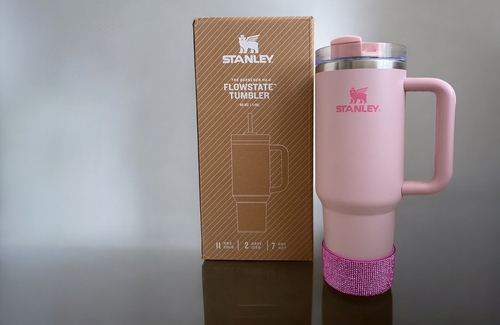
Neutral colourways have proven the most popular options with influencers and customers alike. These natural shades are bang on trend at the moment, and they’re practical too, working with a wide range of outfits. The most popular choice at the moment is ‘rose quartz’, a pinkish nude hue that’s a subtle way to start your collection.
Although Stanley cups have themselves become a must-have accessory, the market for personalising your cup is blooming fast. Stanley offers customisation of your cup with coloured and patterned straws, cup holders that double up as bags and the Stanley boot which is a rubber base for your cup that adds grip. These branded accessories allow you to customise your cup to its fullest potential, and express yourself to the max.
Making it personal
A smart way to customise Stanley Quenchers without heading to Etsy is to have them engraved. At Solopress, we offer the 1200 ml Stanley Quencher H2.0 FlowState Travel Tumbler with laser engraving within a 35 x 90 mm area below the Stanley logo. It’s an ideal opportunity to align your brand with a popular, in-demand product. If it’s a gift for clients or customers, they’re likely to be genuinely grateful. And thanks to the tumbler’s lifetime durability, that appreciation is sure to last. If you prefer a more colourful means of adorning your tumbler, then Stickers are a great way to go. Our Waterproof and Shiny Sticker options are especially suited to bringing a touch of personality and sparkle to your cup.
Copycats and cup couture: the rise of the imitators
A trending brand with a trending product will always attract competitors. With the rise to fame of Stanley cups, we are seeing more and more imitators on the market. These dupes have a variety of familiar Stanley features. These include the iconic handle, straw, and tapered base to allow the cup to fit into cup holders. Many competitor models also feature double-wall vacuum insulation to keep you drink at the desired temperature, but they just don’t have the elusive brand prestige of the Stanley.
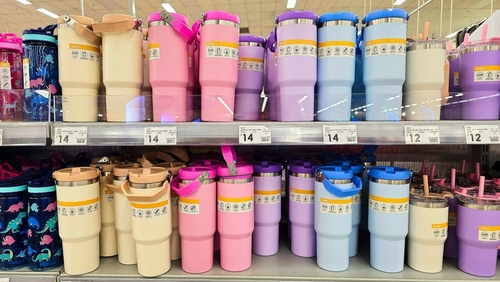
Another way that third parties have jumped on the Stanley band wagon is the production of off-brand accessories. Although there are official accessories, there are limited options and they can be expensive. This has opened the market for other businesses to profit from the Stanley hype. We see straws, bags and covers all designed to personalise your cup at a fraction of the Stanley price. This has become a huge market on Etsy, as you are often able to customise your products with bespoke options and personal monograms.
Although copycat cups have been made to mimic the style of the Quencher H2.0 FlowState™ Tumbler, they will struggle to beat the durability and quality of the original. However, the range of off-brand accessories cannot be matched by Stanley as the options are limitless.
Remaining cool inside and out
With the market becoming ever more competitive, with new rivals cropping up all the time, Stanley faces the challenge of how to stay on top. Rather than relying on churning out the classic, the brand keeps the trend of Stanley Cups in a variety of ways.
The release of new colours and designs creates online trends that maintains the buzz around Stanley cups. New releases off the opportunity to attract new devotees, while Stanley obsessives will snap them up to complete their collections. These customers will also be influenced to by different sized Stanleys, including the adorable new mini-Stanley. Although this will connect with the return customers, the concept of releasing new colours and designs allows everyone to find their perfect product.
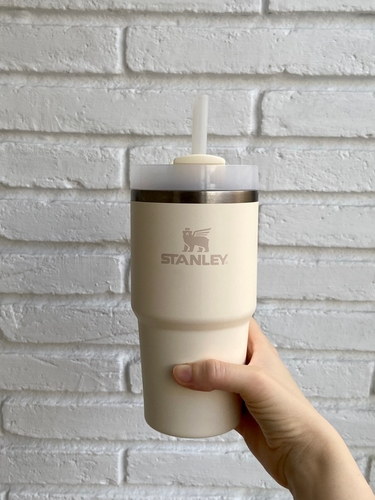
Stanley reaches a secondary audience with their collabs. These special editions pair the brand with influencers and celebrities whose fans might not otherwise engage with the product. For instance, a collaboration with singer Olivia Rodrigo introduced a bespoke Stanley design aimed at her fanbase, creating both a marketing opportunity and a collector’s item.
Where there’s a trend, there’s a backlash
While Stanley cups are riding high at the moment, both the products and their fans have prompted criticism. No sooner had influencers begun showcasing Stanleys as part of their hydration routines than devotees started posting ‘shelfies’—photos of cupboards crammed with Quenchers in every colour of the rainbow. A community of completist collectors quickly emerged, with limited-edition releases prompting round-the-block queues. Some fans now feel compelled to buy every new launch in multiple shades, spending thousands each month just to keep up. The phenomenon has drawn criticism from those concerned about overconsumption and sustainability—as well as from observers who find the whole spectacle a bit cringe.

However, it’s hard to lay blame at the door of a product that—whatever people make of the hype—remains an exceptionally practical and durable item. Made from 90% recycled stainless steel, it offers a lifetime of reusability and stands as a vastly better alternative to single-use plastic bottles. Nor can Stanley be held responsible for the disposable, off-brand accessories that have sprung up around it. Beneath all the noise and novelty, what remains is a well-made, high-quality product that does its job extremely well.
But are they future-proof?
Will the Stanley cup trend endure? The answer isn’t clear-cut. We’ve seen comparable products come and go—take the Hydro Flask, which gained popularity in 2019–2020 but has since faded into the background. That said, the Stanley cup trend has proved more resilient. It’s lasted almost five years and continues to grow thanks to its visibility, quality and wide-ranging appeal.
Crucially, Stanley isn’t a new name. The company has been producing insulated containers for over a century and is now simply connecting with a younger demographic in a new way. Unlike other trends that rise quickly and disappear, Stanley has a foundation in product quality and brand trust.
Hot trend or cool classic?
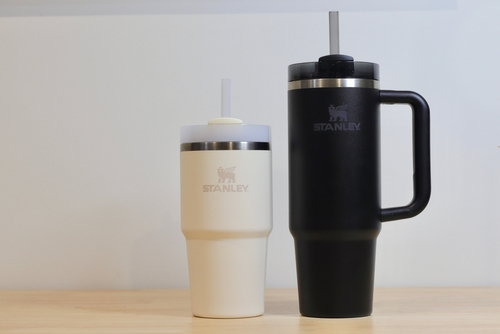
If the focus stays rooted in core benefits—longevity, reusability and performance—Stanley cups could move beyond the status of passing craze to become a long-term staple. It’s entirely possible they’ll earn a place in the hall of fame of classic designs—alongside the Zippo lighter, the Swiss Army knife or the Le Creuset casserole dish. These enduring products have stood the test of time thanks to functional design and solid build quality. If Stanley continues to deliver on those fundamentals, the Quencher could follow a similar path, evolving from viral sensation to permanent fixture.
By helping consumers cut down on single-use plastic bottles, Stanley also has the potential to contribute meaningfully to a more sustainable future—provided that message isn’t drowned out by the hype. It remains to be seen whether Stanley cups are a fleeting trend or here to stay—but they show every sign of sticking around.

